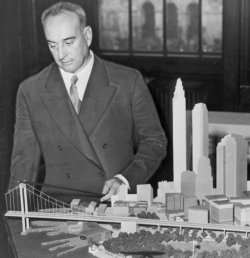Theodore Kheel: My Proposal to Robert Moses
Theodore Kheel (pictured right), has been called by The New York Times "the most influential peacemaker in New York City in the last half-century" in light of the fact that he has participated in the resolution of more than 30,000 labor disputes. Kheel has founded several related foundations devoted to resolving the conflict between the environment and development, and has been an advocate for mass transit for over fifty years. He is a regular Streetsblog reader. A shorter version of this essay appeared in the New York Times this Sunday.
The three commemorative exhibits on Robert Moses, like the press articles covering them, have neglected the mass transit issue almost as seriously as Moses did. The New York Times mentioned in passing that he "championed highways as he starved mass transit" but said no more on the subject. Paul Goldberger, writing for the New Yorker, devoted a few more words to the matter, before dismissing it entirely. He reasoned: "[I]n Moses’s day cities all over the country were building highways at the expense of mass transit. Some critics were complaining but most people didn’t see [the problem] until long after the damage had been done."
Perhaps Moses was doing what everyone else was doing, or perhaps he was leading the others. Whatever our conclusion, it does a disservice to our city to ignore this piece of the Moses story, and what it has to teach us. With that thought in mind, I decided to share with New Yorkers my most notable experience with Moses.
 It was 1965. Moses’ Triborough Bridge and Tunnel Authority was awash in funds; so was the Port Authority, headed by Austin Tobin. Meanwhile, mass transit was strapped for money, and transit workers were demanding higher wages. Moses and Tobin had built empires catering to the automobile, while turning a back on mass transit; they were not concerned.
It was 1965. Moses’ Triborough Bridge and Tunnel Authority was awash in funds; so was the Port Authority, headed by Austin Tobin. Meanwhile, mass transit was strapped for money, and transit workers were demanding higher wages. Moses and Tobin had built empires catering to the automobile, while turning a back on mass transit; they were not concerned.
I decided to make a proposal. I suggested that tolls for the city’s bridges and tunnels be doubled, and the proceeds used to subsidize mass transit. If this two-pronged proposal sounds mundane now, in 1965, it did not. It was front page news in all the city’s papers, including the New York Times; in some, it commanded two inch banner headlines. Moses and Tobin, normally arch rivals, joined immediately in branding the proposal illegal. Later, in an article titled "Is Rubber to Pay for Rails," Moses fumed: "Ted Kheel has gone berserk." "The Kheel scheme is too silly for words." "Of course, nothing will come of it." "Kheel has earned the degree of M.U.B., Master of Unconscionable Bunk."
Harsh words. And maybe a little shortsighted. For a seed of an idea had been planted, and it slowly grew. Within a few years, tolls were doubled and then tripled, and TBTA revenues were eventually used, in part, to fund mass transit.
Fast forward to the present. Once again a transit problem confronts us, as we face the reality that car congestion is strangling the city’s economy, destroying our health, and damaging the atmosphere. And once again, a novel and controversial solution has been proposed, or rather, a pair of solutions, which– like my two-pronged proposal in 1965– would turn car drivers’ pain into mass transit’s gain.
Here are the old ideas in their new clothes. Prong one is congestion pricing: imposing a fee on cars driven in the city, which would discourage some from driving, and raise revenues from those who do; prong two, is free mass transit: eliminating the bus and subway fare, and using the revenues from congestion pricing to cover the costs. The carrot and the stick. Simple enough. But as strange to our way of thinking as my proposal almost half a century ago.
Here’s what they say about these ideas.
First, on congestion pricing, a recent New York Times article reported: "Everyone accepts that if your car is stationary, it’s fine to pay for parking." "But if you tell people they have to pay to move their car between two points, they think it’s crazy." Maybe in New York. But congestion pricing has been adopted successfully in cities like London, Stockholm, Rome, Singapore, Melbourne and Toronto. In fact, as the article acknowledges, "there’s reason to think that we could be entering a golden age for congestion pricing."
What about free transit? I recently funded a $100,000 study of the benefits of free mass transit, in the belief the benefits would outweigh the costs. The concept shocked many. One writer branded my proposal that of "some hippy environmentalists"; others dismissed the idea as hopelessly utopian- not knowing, perhaps, that only a small portion of transit costs are paid today by fare revenues, and that funds from congestion pricing could comfortably cover that amount. Yet the proposal intrigued people, at the same time it surprised them. Newspapers, television stations, and public radio picked up the story. Pictures of crumpled Metrocards circulated on several websites, while another announced "Metrocards Make Good Coasters." Comments streamed in on the blogs. One site described the proliferating discussion as a "free frenzy".
And that takes me back to Moses and the 1960s. The twin concepts of congestion pricing and free transit are seedlings, only recently planted. They make too much sense, however, not to take hold. I predict that fifty years from today, these ideas will seem as mundane as my 1965 suggestion that revenues from Moses’ TBTA be applied to subsidize mass transit. If, however, we remember what Moses did, and Goldberger’s apology that everyone was doing it, perhaps we could move our thinking forward at just a little faster pace. I think we could.